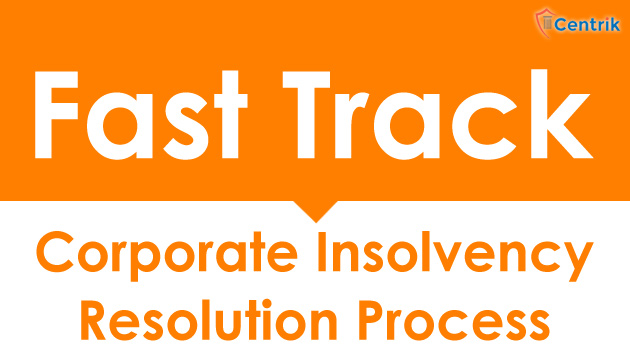
Introduction
Insolvency and Bankruptcy Code, 2016 consolidates and amends the laws relating to reorganization and insolvency resolution of corporate persons, partnership firms and individuals in a time bound manner for maximization of value of assets of these persons, to promote entrepreneurship, availability of credit and balance the interests of all the stakeholders.
Part II of Insolvency and Bankruptcy Code, 2016 deals with matters relating to the insolvency and liquidation of companies and limited liability partnership firms.
In this article we will discuss about the fast track method of filing an application under corporate insolvency resolution process.
What does the Code say about Fast Track IRP?
The Code prescribes fast track corporate insolvency resolution process wherein an application for fast track corporate insolvency resolution process may be made in respect of the following corporate debtors namely:-
- A corporate debtor with assets and income below a level as may be notified by the Central Government; or
- A corporate debtor with such class of creditors or such amount of debt as may be notified by the Central Government; or
- Such other category of corporate persons as may be notified by the Central Government.
The Ministry of Corporate Affairs has notified that the fast track process shall apply to the following categories of corporate debtors:
- A small company, as defined under clause (85) of section 2 of the Companies Act, 2013; or
- A Startup (other than the partnership firm), as defined in the notification dated 23rd May, 2017 of the Ministry of Commerce and Industry; or
- An unlisted company with total assets, as reported in the financial statement of the immediately preceding financial year, not exceeding Rs.1 crore.
Section 56 of the Code requires that the fast track corporate insolvency resolution process shall be completed within a period of ninety days from the insolvency commencement date. The resolution professional shall file an application to the Adjudicating Authority to extend the period of the fast track corporate insolvency resolution process beyond 90 days if instructed to do so by a resolution passed at a meeting of the committee of creditors and supported by a vote of seventy five percent of the voting share.
Upon receipt of such application, if the Adjudicating Authority is satisfied that the subject matter of the case is such that fast track corporate insolvency resolution process cannot be completed within a period of ninety days, it may, by order, extend the duration of such process beyond the said period of ninety days by such further period, as it thinks fit, but not exceeding forty-five days.
However, any extension of the fast track corporate insolvency resolution process under this section shall not be granted more than once.
The application for fast track corporate insolvency resolution process may be filed by a creditor or corporate debtor as the case may be, along with-
- The proof of the existence of default as evidenced by records available with an information utility or such other means as may be specified by the Board; and
- Such other information as may be specified by the Board to establish that the corporate debtor is eligible for fast track corporate insolvency resolution process.
Conclusion
In case of fast track insolvency resolution process the resolution process shall be completed within 90 days after the process is initiated, with a maximum one time extension of 45 days by NCLT. It is important to be aware about the laws that benefit us and now that we have rules that regulate recovery of bad debts the Corporate Creditors should utilize it to their maximum benefit and retract money back to their accounts. NCLT has ensured speedy disposal complying with the rules. With the advent of reformation in the economic situation, the need for these laws have been felt now and then to deal with defaults effectively.
For more information contact us at- stupti@centrik.in
Disclaimer – the above summary is based on the personal interpretation of the revised regulations, which may differ person to person. Hence, the readers are expected to take expert opinion before placing reliance on this article.




 join For Updates
join For Updates